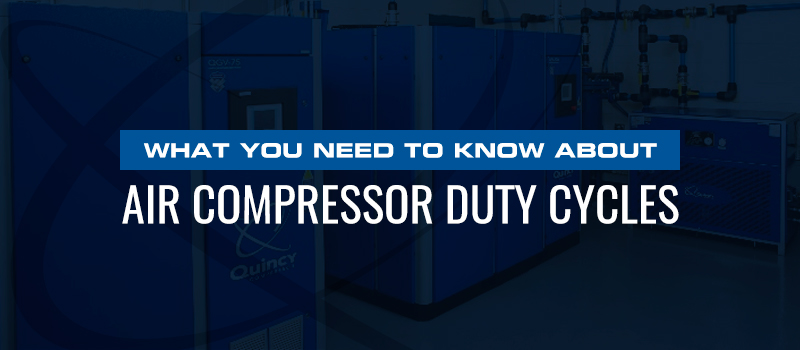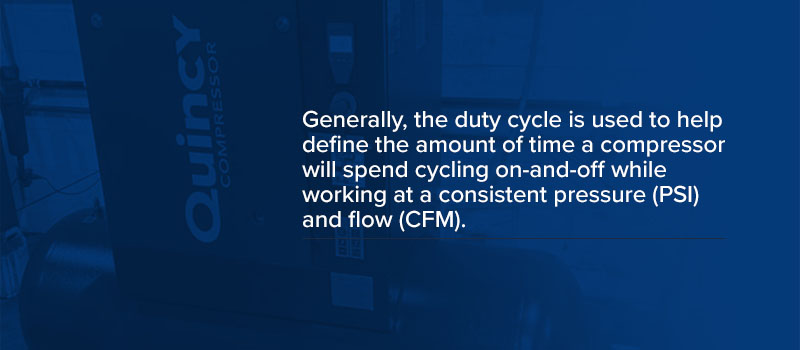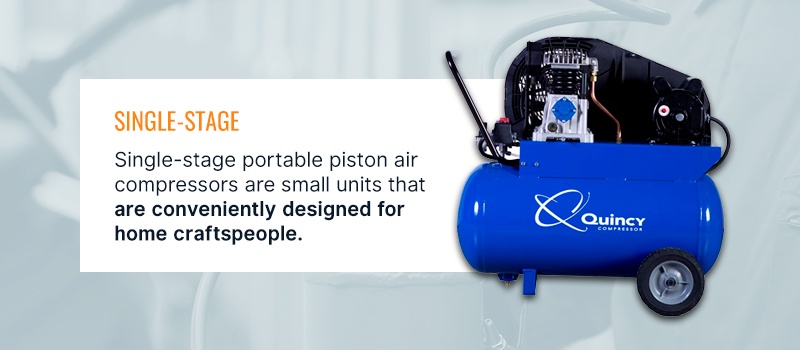Table of Contents

Air compressors are purchased for different reasons by a wide range of companies and independent craftspeople. In some cases, a customer might expect to get a continuous duty cycle air compressor when making that initial investment, only to find the machine in question merely offers a 50% duty cycle. Therefore, it is important to know about duty cycles so you can avoid making the wrong purchase.
What Is an Air Compressor Duty Cycle?
Air compressor duty cycles are easy to understand but often difficult to read because there are no universal characters to represent these values among compressor manufacturers. Simply put, an air compressor duty cycle is the amount of time a compressor will deliver pressurized air within a total cycle time. If listed as a percentage, you can simply take the number of seconds or minutes the figure represents and subtract that from the total cycle time.
When listed as a percentage, the duty cycle is equal to the compressor’s run time divided by the total cycle time. So, this percentage equates to the amount of time you can keep the compressor on, plus the corresponding cool-down duration. For example, a compressor with a 25% duty cycle will need 45 minutes of downtime out of every hour, meaning it can be active for 15 minutes. Likewise, a compressor with a 50% duty cycle will need 30 minutes off for every 30 minutes on.
So, what does the duty cycle mean on an air compressor? It all depends on the percentage figure. The possibilities can be broken down as follows:
1. 25% Duty Cycle
If an air compressor has a 25% duty cycle, it means the run time is one-fourth of the total cycle time. Therefore, if the compressor has a cycle time of 120 seconds, the run time would last for 30 seconds. During operations, the compressor would need one minute and 30 seconds of rest between every 30 seconds of pressurization activity.
An air compressor with a run time this low would mostly be suitable for small applications that require only intermittent air power, such as domestic, portable compressors used by independent craftspeople.
2. 30% Duty Cycle
If the specs of an air compressor specify a 30% duty-cycle rating, this would mean the run time is one-third of the total cycle time. Consequently, a compressor with a cycle time of 60 seconds would have a run time of 20 seconds. When applications are underway, the compressor would need to rest for 40 seconds between every 20 seconds of active use.
An air compressor with a 30% run time could be used in moderate applications where tools are used frequently but not continuously, such as in garages where motor parts need to be fastened and unfastened every few minutes.
3. 50% Duty Cycle
If an air compressor has a 50% duty cycle, the compressor can provide air power for half of its total cycle time. Therefore, if the compressor cycles for a total of two minutes, you can draw pressurized air from the machine for durations of 60 seconds. Then, you will have to wait another 60 seconds before drawing air power again.
Air compressors that offer 50% duty cycles are generally used for medium-scale operations that only necessitate intermittent air power. In some cases, facilities that do not want to invest in larger compressors will make do with 50%-capacity machines.
4. 75% Duty Cycle
Air compressors with a 75% duty cycle will run for three-fourths of the total cycle time. In other words, if a compressor has a 60-second cycle time, it will run pressurized air for 45 seconds of each minute. For various applications, 75% would be considered a sufficient duty cycle, such as in shops where tools are run for brief intervals.
In a repair garage, for example, pneumatic wrenches, screws, nailers and hammers are used for seconds at a time. Since these tools do not require ongoing air, the brief moments of rest time per cycle are only a minor issue.
5. 100% Duty Cycle
If an air compressor has a duty cycle of 100%, the compressor will deliver pressurized air for the entirety of its cycle time. As such, the compressor can be used for processes that require continuous airflow for minutes or hours on end, such as pneumatic sanders and spray painters.
For a compressor to offer 100% duty cycles, the engine must be equipped with a cooling component. Otherwise, the constant pressurization could cause the engine to overheat. A 100% duty cycle will generally be one of the requirements for any air compressor used in a factory setting.
In most cases, duty cycles are performed at 100 pounds per square inch (psi) in moderate temperatures in the lower 70s, typically 72 degrees Fahrenheit. Any deviation from these factors can affect a compressor’s cycle time.
How to Calculate Duty Cycle
What does duty cycle mean on air compressors? The duty cycle of an air compressor, sometimes referred to as run time vs. rest time, is determined using the total compressor cycle time — from when the compressor runs, stops and runs again. Generally, the duty cycle is used to help define the amount of time a compressor will spend cycling on-and-off while working at a consistent pressure (PSI) and flow (CFM).
One complete cycle is considered to be the time it takes to use and fill the tank. That’s why air compressor run-time calculations must also consider the compressor’s rest time, or the time spent off, when determining the duty cycle.
The duty cycle is generally calculated by dividing the compressor run time by the full cycle time. This formula is almost always expressed as — Compressor run time / (run time + rest time) = Duty Cycle percentage.
Consider an air compressor with a total cycle time of 10 minutes that must run for 6 minutes and spend 4 minutes resting or cooling down. Using the duty cycle formula, the calculation is performed as 6 minutes / 10 minutes = 0.6, or 60% duty cycle. The compressor will deliver pressurized air for a combined maximum of 6 minutes and must be off for approximately 4 minutes before it can be used again.
The duty cycle is vital, as it indicates the amount of time a particular compressor should be running and how long it must rest between use. While some compressors are built with thermal protection to shut them down automatically, it’s your responsibility not to overwork the compressor by keeping it off for the correct amount of time.
How Often Should a Compressor Cycle?
The number of times an air compressor cycles significantly impacts the air compression system’s efficiency. Allowing a compressor to cycle more often than the recommended duty cycle can cause it to wear out faster. The number of times your compressor can cycle will depend on the cycle time for that machine and the duty cycle rating.
The cycle time is the amount of time it takes your air compressor to load and unload compressed air. When an air compressor cycles quickly, it consumes more energy. It’s best to have a longer cycle time with fewer cycles per hour to get the most life out of your air compressor. Here are a few ways to lengthen your cycle time and make your air compressor more efficient:
- Use a larger storage tank.
- Try a wider pressure band.
- Drop the pressure between the main storage tank and the compressor.
Vacuum pumps work very similarly to air compressors in that they use the same technology that creates compressed air. These machines also operate using continuous or cyclic processes — with each one possessing its share of pros and cons.
How to Prevent Over-Cycling
Properly size your air compressor to limit the risk of over-cycling and reducing the lifespan of your system. The compressor you purchase needs to work at a duty cycle adequate for your application and meet your PSI and CFM requirements at that duty cycle, too.
It is essential to remember that the duty cycle will also refer to a PSI and CFM for the specified percentage of the total cycle time. For example, a compressor that advertises a 100% duty cycle might provide 125 PSI and 25 CFM for the entire compressor cycle time. However, the same compressor could also be advertised at a 50% duty cycle, providing higher power at 150 PSI and 10 CFM for only half of its total cycle time.
It could benefit you to connect with a dealer who can ensure the model you choose is the best suited for your business.
Applications for Intermittent and Continuous Duty Cycles
Many assume the closer you get to a 100% duty cycle, the better. There are some cases, particularly in manufacturing, where 0% downtime is the goal. However, for tools that don’t need to run for more than a few minutes at a time, an intermittent air compressor is sufficient.
When to Choose an Air Compressor With Intermittent Duty Cycles
Often, an intermittent duty cycle will be enough to help you complete the task at hand without losing productivity. Here are some examples:
- Filling a tire or other kind of inflatable with air — plus other one-time uses.
- Powering mechanics’ tools, such as pneumatic wrenches and nailers, which only need power for seconds at a time every few minutes.
- Completing do-it-yourself home projects.
When to Choose an Air Compressor With Continuous Duty Cycles
Continuous duty cycles allow you to provide constant power to machinery and tools without experiencing downtime. Here are some applications where that can be useful:
- Powering tools used in manufacturing electronics.
- Lifting heavy in-process works in furniture factories and automobile manufacturing facilities.
- Operating conveyor belt systems in bottling plants.
Which Compressors Are Preferred for Continuous Duty?
The types of compressors that generally offer maximum duty cycles are the rotary screw and centrifugal models. Both types are equipped with cooling systems that make it possible to run continuously without damage to the motor.
In a rotary screw air compressor, air passes through the rotors of two counter-rotating helical screws. The rotors are filled with a lubricant that forms an air-tight seal as each generation of air is passed through the compressor. Rotary screw models are typically large units that are most suitable for industrial facilities. Most rotary screw models offer 100% duty cycles, allowing users to power nonstop pneumatic processes. Here are five examples:
1. QGS
QGS rotary screw air compressors are medium-sized units equipped with long-lasting V-belt drives and motors designed for years of constant use. The QGS offers between 125 and 150 pounds per square inch gauge (psig), making these units ideal for a range of tasks that require ongoing volumes of high-intensity air power.
The QGS can also offer anywhere from 16 to 460 actual cubic feet per minute (ACFM), ensuring you can get as little or as much air as you need to flow through the unit at a given time, whether an application demands a restricted or high-volume airflow. QGS series air compressors are designed for 100% duty cycles.
The QGS line of air compressors is good for manufacturing processes that require a regulated, steady airflow on a constant basis, such as electronics productions. In a factory where televisions and stereo components are manufactured, the QGS can power the pneumatic machines and tools used to fasten parts together, from the delicate internal pieces to the sleek outer enclosures.
QGS compressors can also be used to power the air tools used to construct certain computer products and peripheral devices. The QGS rotary screw air compressor can be relied on for lengthy duty cycles above and beyond those required at most electronics plants.
2. QGD
QGD rotary screw air compressors are relatively large units built with gear drives that offer between 15 and 60 horsepower. The QGD is also a reasonably quiet unit with a 66 A-weighted decibel (dBA) sound level. The QGD offers anything from 70 to 281 ACFM, letting you access high-volume airflow or more limited amounts, depending on your needs for the operations at hand. QGDs support heavy-duty cycles and are generally suitable for factory settings.
The QGD line of air compressors is ideal at furniture factories where heavy pieces need to be moved along conveyor belts and fastened into finished products. Formative sofas, tables and chairs move along from one stage of an assembly line to the next. A QGD could power the robot arms that do the heavy lifting and also drive the conveyor systems with precise stop/start precision. As furniture parts travel, the QGD can also power the pneumatic fasteners that connect legs to tables and chairs.
QGD compressors can also be used to finish the surfaces of furnishings that need to be sanded or painted before shipment. With a QGD rotary screw air compressor, you could achieve smooth surfaces and even coats of paint and finish, all thanks to the constant airflow.
3. QSI
QSI rotary screw air compressors are large units built for long-lasting performance in some of the most demanding environments. Made for Power$ync, the QSI offers variable capacity control that allows users to employ the machine for a variety of uses. As far as airflow and intensity are concerned, the QSI provides 220-1500 ACFM and 100-150 psig, giving you a vast range of flow options and sufficient capacity for multiple, simultaneous end-point applications. QSIs are optimal for pressing plants and other intensive work facilities.
QSI air compressors are perfect for bottling plants where liquefied glass is molded into shape with cavity molds and other tools. As a set of bottles are moved in a single file along a conveyor belt, the QSI will power the conveyor system itself with precise timing. The QSI will also power the bottling, capping and labeling tools that turn empty bottles into products ready for the supermarket.
It takes an air compressor like a QSI to consistently fill each passing bottle with the correct ounces of a beverage. Likewise, the tools that slap brand logos onto bottles are timed and controlled by pneumatic-powered instruments.
QSI compressors can also be used to drive the robot arms and machinery that file bottles into carts of six and eight. Many of these same processes are accomplished with the QSI at factories where canned goods are packaged in vast quantities.
4. QGDV
QGDV rotary screw air compressors are big, square units that power some of the most heavy-duty applications at manufacturing plants worldwide. The QGDV features a gear drive that offers between 15 and 30 horsepower, making these units well-equipped for intensive applications.
With actual cubic feet per minute in the range of 70.8 to 141.3, the QGDV is ideal for many pneumatic applications, including some of the heaviest and lightest operations. The QGDV also offers 125 psig, making it possible to power multiple tools and pneumatic devices simultaneously.
QGDV rotary air compressors allow automakers to manufacture vehicles with precision and quality at auto-assembly plants. From the moment a partially assembled vehicle part appears on the conveyer belt, the QGDV powers the robot arms that lift corresponding heavy parts into place for fastening.
The air power makes it possible for automakers to easily assemble heavy vehicle parts that would otherwise be labor-intensive and require a massive workforce. The QGDV also powers the various pneumatic tools that workers along the assembly line use to fasten car parts together.
QGDV compressors are also responsible for some of the processes that turn vehicle bodies into the sleek, freshly painted cars and vans that you find on new auto lots. The QGDV supports maximum duty cycles that make it possible to get shiny, blemish-free paint jobs on large and small vehicles alike.
5. QGV
QGV rotary screw air compressors are big and powerful units that offer between 40 and 200 horsepower, making these compressors ideal for intense applications that necessitate constant airflow. The QGV provides between 180 and 998 ACFM, allowing users to regulate the flow of air to various levels of density. If you need high volumes of air per second, the QGV will deliver.
Likewise, the QGV makes it possible to power applications that demand lighter volumes of air at precise intervals. Moreover, the QGV offers between 75 and 150 psig, allowing you to connect and power numerous devices for simultaneous use.
The QGV line of air compressors can power multiple processes at once at factories in a range of industries. At plants where furnishings and fixtures are manufactured, the QGV can move parts along the conveyor belt for firm and sensitive air-powered applications. At factories where automobiles are assembled, the QGV can power all the heavy-lifting devices and the various pneumatic wrenches, sanders and sprayers along the production line.
QGV compressors are a wise investment for any company that manufactures products in vast quantities, including packaged consumer goods and over-the-counter household items. The QGV is even ideal for weapons manufacturers in the private and government sectors.
Which Compressors Are Ideal for Intermittent Duty Usage?
The types of compressors that are ideal for intermittent use are typically the smaller, portable units of the piston variety. In a piston air compressor, air is drawn into a cylinder and pressurized with a crankshaft-driven piston. In a single-stage compressor, each generation of air is pressurized once, typically with a stroke of 120 psi. In a two-stage piston compressor, the air is sent to a second cylinder and stroked yet again, this time by a smaller piston at upwards of 175 psi.
Piston compressors lack the cooling components necessary for continuous, uninterrupted activity. Therefore, piston compressors are generally limited to smaller duty cycles in the 25 to 50% range. Here are a few examples of small compressed air systems that work for shorter durations:
1. Single-Stage
Single-stage portable piston air compressors are small units that are conveniently designed for home craftspeople. The unit can fit in virtually any room or working space, whether you work with air tools in your garage, kitchen or backyard. The single-stage piston compressor offers between four and 12.4 ACFM, allowing you to adjust the air volume for a small range of applications. With 110 to 145 psi, the single-stage compressor can also power several household air tools simultaneously at intermittent duty cycles.
A single-stage piston air compressor can be used for home crafts, such as the types of products you’d find on Etsy. If you work with materials that need to be glued or painted, the single-stage compressor will power the tools that make the job easier and more efficient. If you need to cut pieces of wood or metal to specific measurements, a single-stage compressor can help you complete the job with ease and satisfaction.
With a single-stage compressor, the days it would normally take to complete a line of homemade products could be reduced to mere hours. Thanks to the power of single-stage piston compressors, craftspeople can now create handmade products at higher volumes and to professional standards.
2. QR-25
QR-25 piston air compressors are small units optimized for a range of applications that require intermittent airflow. The QR-25 offers between one and 25 horsepower, providing sufficient engine capacity for hundreds of operating hours for every service cycle. The QR-25 also provides a range of airflow volumes and speeds with 3-95 ACFM and 20-500 psig, making the unit ideal for home use and smaller business operations. Multiple pneumatic tools can simultaneously work at intermittent duty cycles on the QR-25.
The QR-25 is a perfect choice for home craftspeople who work with metals and auto parts. If you regularly work with vehicles in your garage, a QR-25 will provide air power to your pneumatic wrenches and screws, allowing you to take apart engines and install new components in a matter of minutes, not hours. The QR-25 could also be used to provide pressurized air to sawing tools and pneumatic blow torches in case you ever need to adjust the cut of a metal piece.
The QR-25 can also be used for processes at shops and business buildings that require intermittent air power. If you run a shop where pieces of wood or glass need to be cut to customer specifications, the QR-25 could help you get each job done to each customer’s satisfaction.
3. QP
The QP two-stage air compressor is a small, standing unit that offers a working pressure of 175 psi, allowing users to connect multiple pneumatic tools for simultaneous use at intermittent duty cycles. The QP also provides between three and 15 horsepower, ensuring a healthy working engine through countless hours of operation. QP units are equipped with oil filters and intercoolers, all in a small, round, compact design. The QP is ideal for various applications that require intermittent airflow.
The QP could be the perfect compressor at auto shops where cars and vans are serviced each day. If you run an auto service and repair shop, a QP will power the tools that make it possible to replace vehicle wheels within seconds. The QP will also power the various pneumatic tools that make it easier to perform tasks on various components in a vehicle’s engine sink.
If you need to remove several components to replace a broken or buried part, the QP will power the wrenches required to take apart the engine within minutes.
The QP is also ideal as a compressed-air source for the tools used for minor touch ups on vehicles. If you need to sand a paint crack and touch up the paint on a door or hood, the QP will power the pneumatic sander and paint sprayer for as long as it takes to cover such isolated spots.
Rotary and Reciprocating Air Compressors From Quincy Compressor
Over the past century, air compressors have transformed the industrial sector. From automakers and weapons manufacturers to the shipping and aerospace industries, vehicle and artillery makers have been able to manufacturer items with far greater speed and precision than was ever possible before the 20th century. The power of pressurized air has also radically transformed how foods and beverages are packaged and bottled for mass consumption, allowing brands to boost their productivity.
Since the 1920s, Quincy Compressor has led the way in compressed-air technology, moving beyond the simpler units from those days to the more advanced models of modern times. Today, we sell a range of rotary screw air compressors that offer 100% duty cycles, giving you the ability to run processes on a continuing basis. To learn more about our air compressors or to select the most appropriate model for your business, contact Quincy Compressor or search for a dealer near you.
Contact Us Learn More Find a Dealer Near You
Last Updated on February 21, 2022 at 2:05 pm



